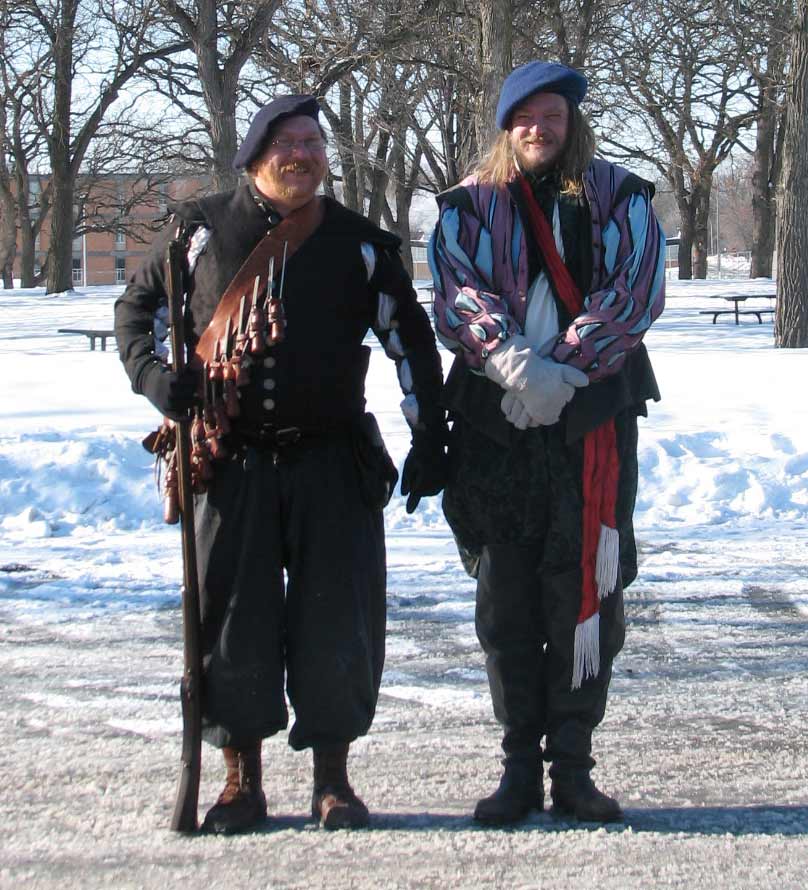Aimed Small Arms Fire: 1580-1650
In some reenactment circles one runs across the notion that for a soldier of this period to deliberately aim his firearm at a specific human target was to commit murder, and as such was a punishable war crime.
Massed infantry fire was often not aimed in this period and even later. Furthermore, it is understandable that a musketeer might avert his eyes as protection from the flash. However, to have scruples about aiming being murder is quite a different thing, and frankly seems absurd given the general character of the 30 Years War and other conflicts of the era. In fact, after considerable searching I have been unable to find any period documentation of this concept.
What I have found is that aimed small arms fire was an accepted, and indeed, important part of warfare in and around this period. Some soldiers are described as "sharpshooters" or "marksmen" and sniping was a documented tactic. Examples follow:
- 1580. Glenmalure. Ireland.
"The English were sniped at for a long period of time before their discipline collapsed and they turned and fled down the valley." -- Battle of Glenmalure information
"Rebel harquebusiers, continued to pick off fleeing troops. Clad in bright coats of scarlet and blue, targets were easily visible." -- The Battle of Glenmalure
- 1595. Clontibret, Ireland
"THE great General Norris, with his army, entered Oriel in MacMahon's country and came to a place not far from Monaghan which is called Clontibret (Cluoin Tiburuid), where he displayed his forces to the enemy. O'Neill, not less skilful as a general, but inferior in strength, came against him. Here for the faced each other. The ground here was an open and level plain, but somewhat heavy with moisture. The waters flowing from the surrounding bog formed a ford over which the English might most conveniently cross. O'Neill blocked this ford; Norris tried to force it. O'Neill endeavoured to drive him back. A cavalry fight and musketry skirmish commenced simultaneously round the ford. The Royalist horse were better armed; the Irish troops were more nimble. The Irish sharpshooters were far better marksmen. This advantage was often common to both parties since there were generally more Irish than English in the Royalist army. The Queen's musketeers were twice worsted by the Catholics, and recalled by Norris, who was always the last to leave the fight, and had even a horse shot under him by a leaden bullet." -- Philip O'Sullivan Beare, Chapters towards a History of Ireland in the reign of Elizabeth, 1621
- 1632. Sweden and Germany
"Krak's gameshooters were a small élite body of mounted Swedish marksmen that followed Gustavus in Germany. They were issued by the state with small-bore hunting muskets, which may have been rifled and were clearly ideal sniping weapons". -- Brzezinski and Hook, 1993. p.38
"The main weapons of Krak's sharpshooters, which were issued by the state, were hunting guns called fögelbössor--fowling pieces--or Smålands bössor, after their main place of manufacture. These were small bore weapons of only 8mm to 10mm calibre (compared with about 19mm for muskets), fitted with snaphaunce locks (proto-flintlocks and usually rifled)." -- Brzezinski and Hook, 1993. p.38
- 1642-1653. British Isles.
"Gamekeeper turned Sniper"
"The firearms issued to the common soldiers during the [British] Civil Wars were cheap and inaccurate; but better weapons--many with rifled barrels--were available, often in the hands of civilian hunters and gamekeepers. The siege was a situation where the slow rate of fire of these weapons did not greatly matter, and both besieged and besiegers suffered from the attention of the accurate fire of these marksmen. Officers were a natural target and would often have to disguise their rank when appearing in the outworks...." -- Tincey and McBride, 1990, p. 57
- 1642-1653. British Isles.
"Although the articles of war stated that it was illegal to deliberately maim or kill a drummer, this did not prevent them becoming targets in reality. His bright clothes, conspicuous appearance and value to the regiment must have tempted many an enemy sniper. The loss of drummers could effectively hinder a regiments performance upon the field" -- The Drummer
This is as close as I have been able to come to the original claim. Three points stand out:
- That drummers enjoy such special protection (it is not legal to "deliberately maim or kill them") implies that others on the battlefield do not. It is perfectly legal to "deliberately maim or kill" them.
- The protection was not worth much. The temptation of crippling an entire block of enemy soldiers with a single shot could be too much to resist.
- The existence of snipers is assumed.
- 1643. Roundway Down, England.
Richard Atkyns (Royalist) describes his encounter with the heavily armored Sir Arthur Haslerigge (Parliament) in this major victory for the King.
"He discharged his carbine first, but at a distance not to hurt us, and afterwards one of his pistols, before I came up to him, and missed with both; I then immediately struck into him, and touched him before I discharged mine; and I'm sure I hit him, for he staggered, and presently wheeled off from his party and ran. I came up to him, and discharged the other pistol at him, and I'm sure I hit his head, for I touched it before I gave fire." -- quoted in Tincey and McBride, 1990, p. 14
This illustrates that pistols were used at very close range (and hence obviously aimed) to have any chance of penetrating a cuirassier's armor (In fact, Sir Arthur survived the battle).
Printed (non-web) References
Richard Brzezinski and Richard Hook, The Army of Gustavus Adolphus (2): Cavalry, Osprey Men-at-Arms 262, London, Osprey, 1993.
John Tincey and Angus McBribe, Soldiers of the English Civil War (2): Cavalry, Osprey Men-at-Arms 27, London, Osprey, 1990.

